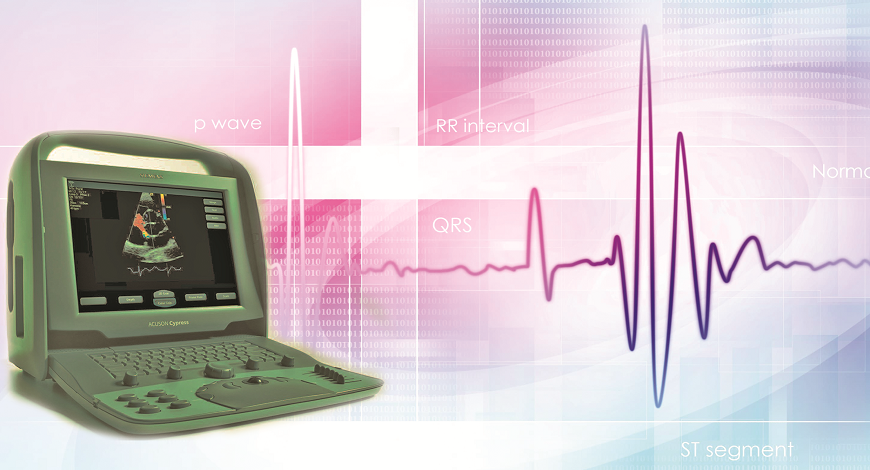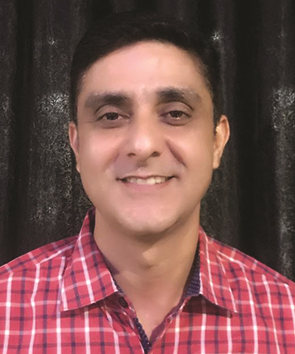ECG Equipment
Real–Time ECG Algorithms Is The Way To Go!

ECG monitoring is fast heading toward online, real-time monitoring combined with short algorithms or AI.
New patient monitoring technologies with wireless connectivity have enabled a revolution in cardiac event and Holter monitoring in the past few years. There is a movement toward real-time, remote cardiac monitoring with the latest generation of event and Holter monitor systems. However, to be successful and to be able to sort through and make large amounts of streaming, real-time information actionable, a high level of automation is necessary. This is where smart algorithms and artificial intelligence (AI) are playing an increasingly larger role in cardiology.
A differentiation needs to be made between systems offering continuous recording and continuous monitoring. If a system does not have a way to wirelessly connect to a monitoring company, clinicians will not be notified of any critical events until after the monitoring device is returned to the doctor’s office. With real-time monitoring, if enough data is collected to make a specific diagnosis, the patient can be notified to come back to the doctor’s office for a consultation, rather than waiting days or weeks for the patient to drop off the device and have the data downloaded and analyzed. This can speed patient therapy and potentially cut the time needed to monitor patients.
The length of monitoring today is also starting to extend beyond the traditional 48 hours to several days or weeks. Capturing larger amounts of real-time cardiac data allows for a complete picture of a patient’s cardiovascular health. Real-time monitoring also can allow for immediate intervention, or patient callbacks if enough data has been gathered to diagnose their condition. The depth of data from devices recording all cardiac function 24/7 offers a clearer picture over a small snippet of information from a couple of events, or from short duration 24 to 48-hour recordings. This depth of data also allows for more detailed statistical analysis.
However, capturing vast amounts of data over days or weeks would be labor intensive to manually dig through to extract relevant data, or to tabulate statistical analysis. For this reason, numerous vendors now offer software algorithms to automate this review process. Several days’ worth of data can now be processed in minutes to pull out the relevant information and condense it into a useable report format for cardiologists.
Indian market
The Indian ECG equipment market in 2018 is estimated at Rs 268.48 crore. In value terms, the high-end machines account for a 60 percent share, albeit only a 26 percent share by volume. By volume, the 3-channel systems lead the market, contributing 34 percent to the market. In spite of declining demand, the single channel ECG equipment continues to have a stronghold in the market, with a 52 percent share, by value. This is in contrast to the global scenario, where the 3-channel and single channel ECG devices are poised to exit the market, with the upcoming trend of CCAA (culprit coronary artery algorithm), promising to predict where exactly the block is located in the coronary artery in case of heart attack or chest pain.
| Tier I | Tier II | Tier III | Others |
|---|---|---|---|
| Philips and Schiller | BPL, Mindray, and GE | Nihon Kohden, Skanray, Edan, and Nidek Medical | Silverline Meditech, Krishna Medi Equipment, Nasan, JK Medical (Bionet), and many Chinese brands |
| *Vendors are placed in different tiers on the basis of their sales contribution to the overall revenues of the Indian ECG equipment market. | |||
| ADI Media Research | |||
In the high-end ECG segment the 12-channel ECG machines contribute 72 percent, by value and 84 percent, by volume. The low-end stress ECG machines are also popular with an 11 percent share, by value and 8 percent share, by volume. The low-end Holter, the high-end Holter, and the high-end, stress-test ECG machines, each have a market share in the vicinity of 5 percent, by value.
In 2018, whereas ECG machines from Philips and GE continued to be sold, combined with other equipment as packages, primarily for ICUs; Schiller and BPL gained ground through the retail segment. Mindray continued to find success in tenders invited by the government’s medical facilities.
Global market
The global ECG equipment market size is expected to reach USD 7.4 billion by 2024, rising at a market growth of 6.1 percent CAGR during 2018-2024. Technological advancements of ECG devices like portability, handheld, novel electrodes and sensors, and smartphone integration are likely to contribute to the market growth. Additionally, growing cases of cardiovascular diseases along with significantly growing older population further adds to the market growth. Moreover, the emergence of novel ECG devices such as handheld ECG devices and ECG devices integrated with Artificial Intelligence systems is expected to add to the growth of the market.
The single-lead ECG monitors market was valued at around USD 378 million in 2018 and is estimated to touch a noteworthy valuation of more than USD 730 million by the end of the year of assessment (2025). The global market for single-lead ECG monitors is expected to rise at a huge CAGR of 9.9 percent with respect to value throughout the period 2018 to 2025. This growth is pushed by the adoption of single-lead ECGs across the globe in application areas such as atrial fibrillation indications, conduction disorders, bradycardia, and tachycardia. Moreover, the presence of chronic disorders and cardiovascular diseases has contributed to the increasing use of single-lead ECG monitors in hospitals, home care and other among end users. Also, the growth of the global single-lead ECG monitors market is backed up with increasing technological advancements in the medical device sector coupled with increasing distribution network and sales channels. There is an increasing prevalence of lifestyle diseases, such as heart diseases, atherosclerosis and stroke, obesity, diabetes type II, and other diseases associated with alcohol consumption, smoking and high drug abuse. Owing to an unhealthy lifestyle and diet, and increasing tobacco use and physical inactivity, heart diseases, and stroke are the most common among individuals across the world. Raised glucose level, high blood pressure, overweight, high blood lipids, and obesity are the primary symptoms of heart-related disorders that can be measured in primary care facilities and hospitals. This has spurred the adoption of single-lead ECG monitors across end users in the globe.
The ECG equipment market in North America is expected to hold the largest share by 2025 as the possibilities of the rising number of lifestyle-oriented diseases, increased spending rate for healthcare, and technological advancement in cardiology segment could drive the market ahead. There has been an increase in pressure for hospitals to become paperless to curb costs as a result of the US healthcare reforms. Hence, the use of ECG devices that can be connected to the integrated data management systems of hospitals or the use of electronic medical records to maintain patient databases has increased in the recent past. On the other hand, the Asia-Pacific market is anticipated to the fastest-growing region for the ECG equipment market. This region is expected to exhibit substantial growth in this market during 2018-2025.
Leading firms are increasingly focusing on expansion in developing countries such as India and China, where the market still has an opportunity to grow at a fast rate due to the growing medical tourism industry and manufacturing cost advantages. As a result of the increasing awareness about cardiovascular diseases and increases in public expenditure on healthcare services in such countries, there has been an increase in the demand for diagnostic ECG devices. Some of the global key players are BioTelemetry Inc., Compumed Inc., GE Healthcare, Mindray Medical, Hill Rom, Nihon Kohden Corporation, Philips Healthcare, Schiller AG, Spacelabs Healthcare, Welch Allyn, CardioComm Solutions Inc., McKesson Corporation, Device Technologies, and Meditech.
Technological advances
In the late 1990s and early 2000s, several vendors introduced first-generation smart algorithms for automatic arrhythmia detection with in-hospital patient monitoring systems. There were high hopes this technology would eliminate the need for human monitoring of the ECG data. But, while these systems worked well in product demos, they did not always perform as well in real life. However, this technology has greatly improved over the past decade and is now being used with event monitors, holters, wearable devices and smartphone-based ECG monitors.
Smart algorithms integrated into most holter monitoring systems are retrospective and do a pretty good job of determining premature ventricular contractions (PVCs), tachycardia, bradycardia, pauses, and normal rhythms, but atrial fibrillation (AFib) has been a problem for some algorithms. More recently, some vendors have developed AI-based software to do a better job of detecting AFib. Examples of this include ScottCare’s TeleSense wi-fi event monitor and HolterCare analysis software. AliveCor, which offers a clinical grade, smartphone-based, single-lead ECG device, also developed an algorithm in its app to help detect AFib. iBeat, CardioLogs and other vendors also have recently introduced AFib detection software.
Most of the current generation remote cardiac event and holter vendors offer smart software that can autogenerate complete statistical reports with graphical presentation of arrhythmias, pauses, heart rate, and other parameters in an easy-to-read diagnostic report.
Advanced AI algorithms are now entering the market. AI will operate in the background of the monitoring software, constantly reviewing real-time streamed patient data, or quickly reviewing days or weeks of recorded data in seconds. This will likely be a big help in triaging cardiac events. However, AI is not a perfect one-size-fits-all solution. AI might be extremely helpful, but physicians need to understand its limitations. Also, not all patients have the exact same clinical presentations that neatly fit into pre-defined software grading categories.
Automated, advanced reporting. A good example of a company that has developed advanced, automated real-time review software is Medicalgorithmics’ PocketECG solution. It offers an algorithmically advanced system that combines software, hardware, and telecommunications into one platform. Physicians can access full-disclosure ECG data and complete statistical reports online on any device through a standard web browser. It also has a built-in accelerometer to correlate the patient’s physical activity to arrhythmia and symptoms. The vendor said this can be useful for the rate control in the management of AFib.
The PocketECG technology recognizes the morphology of each individual heartbeat and allows differentiating between normal and abnormal heartbeats including ventricular ectopy, supraventricular ectopy, aberrated supraventricular beats and waveform artifacts. This functionality monitors the continuous stream of real-time, remote monitoring ECG data for up to several weeks. It calculates heart rate variability (HRV) statistics over the extended monitoring period. The system also has the ability to calculate detailed arrhythmia statistics for extended monitoring and to identify HRV changes and morphology of each individual QRS complex.
The automated analysis software allows the creation of several different reports. It offers rate and rhythm analysis and percentage reports on sinus rhythm beats versus atrial fibrillation beats per minute by day recorded. The system also identifies the morphology of each beat to aid analysis of the frequency of ventricular and atrial ectopic beat occurrences per minute, hour, day, week or month. It also can detect ventricular and superventricular tachycardia and complex arrhythmias like ventricular and supraventricular bigeminy and trigemini. This can help measure the conduction of heart rate variability and heart rate turbulence.
Cardiac Insight’s Cardea Solo patch-type monitor system is being marketed to providers as a way to eliminate the extra step and fees associated with using a third-party company to review and record the data. Instead, the provider pulls a data pod from the wearable device and plugs it into a reader and the software automatically downloads the continuously recorded patient data. The comprehensive data can be retrieved in the physician’s office for analysis using the software’s robust set of ECG algorithms and interactive full-disclosure trace review tools.
Outlook
There is a shift occurring in ECG monitoring technology used in Holters and cardiac event recorders that may help speed or enhance the diagnosis of arrhythmias. As already seen in business and consumer information technologies, there has been a revolution in recent years for how much and how fast digital data can be transmitted wirelessly. Data storage also has greatly expanded and the costs have significantly dropped. Lastly, complex software algorithms can now sort through large volumes of data to pull out specific, useful information to greatly reduce the amount of time it would take to review it manually. These components have come together in cardiac monitoring devices to enable real-time, 24/7 monitoring on all data. The future standard of care will likely be online, real-time monitoring combined with smart algorithms or AI.
Industry Speak
Higher Sampling Frequency Will Be On The Rise
Amit Tickoo
General Manager
Schiller India
On market trends
Market of ECG devices is growing by 20 percent every year. A major contribution has been through sales of high-end ECG machines compared to single channel and 3-channel machines.
On technology trends
2018 saw some new innovative technology in ECG, be it portability, higher sampling frequency, or better display with additional software.
On key growth drivers
As usual 2018 was driven by 12-channel ECG market compared to 3-channel and single channel. Major contribution in terms of revenue was trough high-end ECG devices.
On buyer’s perspective
Earlier buyers used to look for cheaper options, but 2018 witnessed change in that trend. With better and innovative technology buyer has started looking for high priced ECG devices.
On challenges and opportunities
Increase in 12-channel ECG market shows that market is more driven toward high-end ECG machines. There has been a sharp decline in sales of single channel ECG machine, which is likely to phase out in the near future. Customers have been demanding high-end ECG devices, specially the 12-channel wherein they get innovative technology with better results.
On outlook
Future will see an increase in demand of high-end ECG machines, including holter systems. Demand for features like CCAA (culprit coronary artery algorithm) is likely to increase in the near future. In the coming years there will be a sharp decline in the demand for old technologies, while demand for higher sampling frequency which is a fairly new technology will be on the rise as higher sampling frequency in ECG devices will help the end-user to diagnose better.
Industry Speak
Electrocardiograph – Market Trend
N. Manogaran
Vice President –Sales
BPL Medical Technologies Pvt. Ltd.
The electrocardiograph is a segment which grows consistently being a preliminary tool to diagnose heart diseases. Rest ECG, Stress ECG and Holter ECG are the different needs depending on patient’s symptoms. Rest ECG is commonly used.
Rest ECG. Single channel, 3 CH, 6 CH, and 12 CH are different types of ECG equipment available in the market. The demand for a single channel is reducing and multichannel growing. The basic need of ECG equipment is to print 12 lead ECG (Lead I, II, III, avR, avL, avF, and V1-V6) though, various other features are added to the user and patient advantage. Auto printing mode has become a must and gives great comfort to both user and patient. An LCD display is important to check the connections to the patient and used for equipment set up. Alpha-numeric keyboard feature is very useful to input patient details quickly. Simple and minimal, easy to use keys are preferred by users. ECG measurement and analysis with electrocardiogram is of great use and offered by most manufacturers. Interpretation using proved algorithms are also gaining importance. Glasgow algorithm is one of the widely accepted rest ECG- algorithm. Q-T interval, QT dispersion, HRV are some of the useful measurement gaining importance to get information about heart health.
Days to come, 3 CH ECG equipment may be accepted as entry-level ECG and 12 CH ECG equipment may become the preferred choice. Like any other devices connectivity options become the need of the day. USB connectivity, DICOM, and HL7 are becoming user demands currently. ECG is the first parameter being used in telemedicine for long time. There are so many solutions available for transferring patient ECG to remote locations for medical advice and treatment. Devices available today for patients who can acquire their own ECG and send it through smartphone to doctor for medical advice.
Stress ECG. Stress ECG is next commonly used a diagnostic system to study stress ECG of a patient. The system provides some standard test protocols like Bruce, Modified Bruce etc. Shorter length patient leads (cable) to acquisition device, higher sampling rate, and heavy-duty treadmill are the features that decide customer purchase. Bluetooth instead of wired connectivity find increasing demand. The high-end system offers auto NIBP measurement and report in stage reports.
Holter ECG. This device can help the patient to record 3 or 12 CH ECG for 24 hrs to 7 days, which can be reviewed by his cardiologist. The ECG Holter system has a device to acquire ECG and software to analyze the recorded ECG. Lightweight, small size is preferred by patient for his comfort. Electronic memory over memory cards can have safe storage till its download to the holter software for review and analysis. Cardiologists decide to buy based on review/analysis software and the size of the acquisition device.
Industry Speak
Technological Advancements And Emerging Trends
Sumi P. Potty
Design Engineer – Research & Development
Skanray Technologies Pvt. Ltd.
The electrocardiogram (ECG) has been used as a diagnostic tool for cardiac rhythms over a centenary, although the theories being remnant where the test equipment is emerging to meet the technological boom. This includes the portability, flexibility, contoured workflow, hardware interoperability so that data can be quickly incorporated with the electronic medical records. There has been an inclination in the past decennium towards the minor, compact, mobile ECG monitoring systems that can be used in hospitals, clinics or either in the home by the patients.
Automation in ECG
Most of the ECG equipment that has standard interpretation algorithms, which identifies rhythm morphologies, ST mappings, ST segment elevation myocardial infraction (STEMI), arrhythmia, and faulty artery identification. The capability of the machine to transfer, view and download the health information online is critical in this era. Cloud and smartphone-based interoperability provide ease of access to the doctors as well as clinicians who are working off hours and can be accessed even in remote locations.
Internet of medical things (IoMT)
Huge demand for the electronic patient monitoring systems is bolstered by the technological advancement where the conventional 12 lead ECG monitoring will hover in a mainstay. The forthcoming cardiac assessment may deviate the patients emphasize more on the inexpensive wearable or web-based ECG monitoring systems which are much easier to use. The wearable body sensors will continuously monitor the patient data where the data can be transmitted, processed in a server with the aid of technological advancements. Future ECG equipment with the help of IoMT will focus more on the patient’s psychological and emotional state which will regulate the information based on the data.
Telemetry
ECG had been in the vicinity as a diagnostic tool for a long time, and the invasion of ECG machines in the hospital is very high. The need to monitor the patient for an extended period of time resulted in the invention of homebound telemetry equipment. Despite of its conventional nature the ECG equipment continues to boom with latest innovations with event monitors which record cardiac rhythm for a period of time with increased accuracy and compliance. These devices can store data for a prolonged period of time and can monitor patients in their homes with implantable loop recorders which are surgically inserted.












